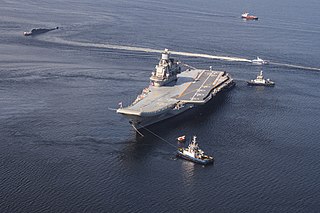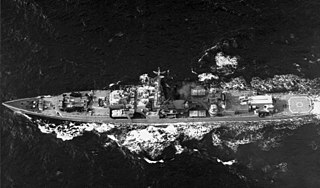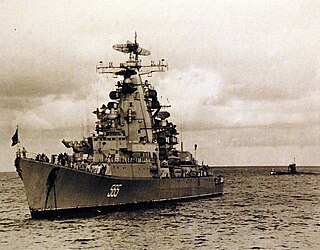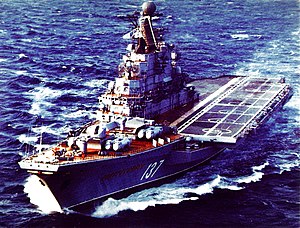
The Kuznetsov-class aircraft carrying cruiser, Soviet designation Project 1143.5, is a class of aircraft carriers operated by the Russian and Chinese navies. Originally designed for the Soviet Navy, the Kuznetsov-class ships use a ski-jump to launch high-performance conventional aircraft in a STOBAR configuration. The design represented a major advance in Soviet fleet aviation over the Kiev-class carriers, which could only launch VSTOL aircraft. The Soviet Union's classification for the class was as a heavy aircraft-carrying cruiser, which permits the ships to transit the Turkish Straits without violating the Montreux Convention. However, the Chinese variants are classified as aircraft carriers.

The Kirov class, Soviet designation Project 1144 Orlan, is a class of nuclear-powered guided-missile battlecruisers of the Soviet Navy and Russian Navy, the largest and heaviest surface combatant warships in operation in the world. Among modern warships, they are second in size only to large aircraft carriers, and of similar size to a World War I-era battleship. The ships are often referred to as battlecruisers by Western defence commentators due to their size and general appearance. The Soviet classification of the ship-type is "heavy nuclear-powered guided-missile cruiser".

An anti-ship missile (AShM) is a guided missile that is designed for use against ships and large boats. Most anti-ship missiles are of the sea skimming variety, and many use a combination of inertial guidance and active radar homing. A large number of other anti-ship missiles use infrared homing to follow the heat that is emitted by a ship; it is also possible for anti-ship missiles to be guided by radio command all the way.

Baku was a Kiev-class aircraft carrier of the Soviet Navy and the Russian Navy from 1987 to 1996. In 1991 the ship was renamed Admiral Flota Sovetskogo Soyuza Gorshkov in Russian service.

Kirov is the lead ship of the Kirov class of nuclear-powered guided missile cruisers. Originally built for the Soviet Navy and passed onto the succeeding Russian Navy, she and her three sister ships are the largest and heaviest surface combatant warships built by them. The Soviet classification of the ship-type is "heavy nuclear-powered guided missile cruiser", nonetheless Kirov's size and weapons complement have earned her the unofficial designation of a battlecruiser throughout much of the world, as her size and displacement is similar to a typical World War I battleship. The appearance of the Kirov class was a significant factor in the U.S. Navy recommissioning the Iowa class. She was named after a Project 26 cruiser.

The Moskva class, Soviet designation Project 1123 Kondor (condor) and S-703Project 1123M Kiev, was the first class of operational aircraft carriers built by the Soviet Union for the Soviet Navy.

The Sverdlov-class cruisers, Soviet designation Project 68bis, were the last conventional gun cruisers built for the Soviet Navy. They were built in the 1950s and were based on Soviet, German, and Italian designs and concepts developed before the Second World War. They were modified to improve their sea capabilities, allowing them to operate at high speeds in the rough waters of the North Atlantic. The design carried an extensive suite of modern radar equipment and anti-aircraft artillery. The Soviets originally planned to build 40 ships in the class, to be supported by the Stalingrad-class battlecruisers and various aircraft carriers.

The aircraft cruiser is a warship that combines the features of the aircraft carrier and a surface warship such as a cruiser or battleship.

Novorossiysk was a conventionally powered aircraft carrier that served the Soviet Navy and the Russian Navy from 1982 to 1993. She was the third Kiev-class vessel to be built. She was designed to engage in offensive actions as a guided missile cruiser mostly using her deck mounted missiles as well as support anti-submarine and surface actions with her embarked air group.

Kronstadt was a Project 1134A Kresta II-class cruiser of the Soviet Navy, named for the Kronstadt naval base. The first ship of her class, the ship served during the Cold War, from 1969 to 1991. She served with the Northern Fleet, with her shakedown cruise being through the Mediterranean Sea. After colliding with a destroyer in 1975, she spent five years being repaired and modernized. She was decommissioned in 1991 before being sold for scrap two years later due to reduced naval funding and deteriorating conditions.

Groznyy was the lead ship of the Soviet Navy Project 58 Groznyy-class guided missile cruisers, also known as the Kynda class. Originally designated a destroyer, the vessel was reclassified as a cruiser on 29 September 1962.

Admiral Isakov was a Kresta II-class cruiser of the Soviet Navy and briefly of the Russian Navy, named for Soviet admiral Ivan Isakov. The second ship of her class, she served mostly during the Cold War from her commissioning in 1970.

Admiral Zozulya was the lead ship of the Soviet Navy Project 1134 Admiral Zozulya-class Large Anti-submarine Ship also known as the Kresta I Class guided missile cruisers. Launched in 1965, the ship was reclassified a Large Rocket Ship in 1977. Admiral Zozulya served primarily in the Northern Fleet during the Cold War, transferring to the Russian Navy at the dissolution of the Soviet Navy, and was decommissioned in 1994 after nearly thirty years of service.

Vitse-Admiral Drozd was the third ship of the Project 1134 Berkut Large Anti-submarine Ships built for the Soviet Navy, also known as the Kresta I-class or Admiral Zozulya-class guided missile cruisers. The vessel was launched in1966 and served with the Baltic and Northern Fleets through the 1970s and 1980s. As well as taking part in naval exercises in the Atlantic, the ship assisted in the rescue of the crew of the stricken submarine K-19 in 1972. As a consequence, the ship was named in the Northern Fleet's book of honour. The vessel was reclassified a Large Rocket Ship in 1977 to reflect its multi-purpose capability. After an upgrade in 1981, Vitse-Admiral Drozd continued to operate in the Mediterranean Sea and Atlantic Ocean. The vessel observed the 1986 United States bombing of Libya and undertook good will visits to Annaba and Dubrovnik as well as Tripoli. After being decommissioned in 1990, the ship was sent to India to be broken up in 1992 but sank en route.

Admiral Makarov was a Project 1134A Berkut A class cruiser of the Soviet Navy and briefly of the Russian Navy. The fourth ship of her class, the ship served mostly during the Cold War, from 1972 to 1992. She served with the Northern Fleet for the duration of her career, often operating in the Atlantic and the Mediterranean in order to show the flag, and was refitted between 1983 and 1985. She was decommissioned in 1992 due to deteriorating conditions which reduced naval funding prevented from being addressed before being sold for scrap in 1994.

Marshal Voroshilov was a Project 1134A Berkut A class cruiser of the Soviet Navy, which briefly became part of the Russian Navy after being renamed Khabarovsk in 1991. The fifth ship of her class, the ship served mostly during the Cold War, from 1973 to 1992.

Vasily Chapayev was a Project 1134A Berkut A class cruiser of the Soviet Navy named for the naval commander Vasily Chapayev. The Project 1134A vessels were envisaged as a counter to the attack and ballistic missile submarines operated by the members of NATO. To that end, they were equipped with two KT-106 quadruple launchers for eight 85R anti-submarine missiles in the URPK-3 Metel system. The ninth ship of the class, Vasily Chapayev was launched in 1974 and served during the Cold War with the Pacific Fleet. Based at Vladivostok, the ship travelled extensively in the Indian and Pacific Oceans, visiting a large number of friendly ports in Angola, Ethiopia, India, Mozambique and Yemen. In 1978 and 1979, the vessel formed part of a Soviet flotilla, including the Project 68bis cruiser Admiral Senyavin, that supported Vietnam in the aftermath of the Sino-Vietnamese War. In 1982, Vasily Chapayev was allocated to support the BOR-4 spaceplane programme, and two years later, the vessel participated in a search for a US Navy submarine that was suspected of being near the Kamchatka Peninsula in the Russian Far East. In 1985, the ship took part in a simulated joint operations attack on the US base at Pearl Harbor that involved the coordinated use of aircraft, ships and submarines. During the following year, the vessel took part in first joint exercises that involved both the Soviet and North Korean Navies. Taken out of active service in 1992, Vasily Chapayev was decommissioned and transferred to be broken up in 1993.

Admiral Isachenkov was a Project 1134A Berkut A large anti-submarine ship of the Soviet Navy. The seventh ship of the class, the vessel was launched in 1972 and served during the Cold War with the Northern Fleet, often operating in the Atlantic Ocean but also travelling to various ports in the Mediterranean Sea. The ship acted as flagship for the Minister of Defence, Marshal of the Soviet Union Andrei Grechko, during the exercise Okean-75 in 1975 and operated alongside the newly launched Project 1143 Krechyet aircraft carrier Kiev in 1977 and 1978. The ship also shadowed the NATO aircraft carriers HMS Ark Royal, USS Independence and USS John F. Kennedy. The cruiser was taken out of service for repairs in 1981 and substantially upgraded with new weapons and communications systems, re-entering service in 1982. With the end of the Cold War, the Navy reassessed its need for large warships and, after a career stretching nearly twenty years, Admiral Isachenkov was decommissioned in 1992 and sold to be broken up.

Vladivostok was the second Soviet Navy Project 1134 Admiral Zozulya-class Large Anti-submarine Ship also known as a Kresta I guided missile cruiser. Launched on 1 August 1966, the ship was reclassified a Large Rocket Ship on 3 August 1978 to reflect the wide-ranging capability of the vessel. Serving primarily in the Pacific Fleet during the Cold War, Vladivostok took part in exercises and tours that demonstrated Soviet naval power in the Indian and Pacific Oceans. The ship played a part at a number of points of potential escalation in the Cold War, including the Indo-Pakistani War of December 1971 and the collision between the aircraft carrier Kitty Hawk and the submarine K-314 in March 1984. Vladivostok was taken out of service to be modernised and updated on 28 September 1988 but there were insufficient funds to complete the work. Instead the ship was decommissioned on 19 April 1990 and, the following January, sold to an Australian company to be broken up.



















